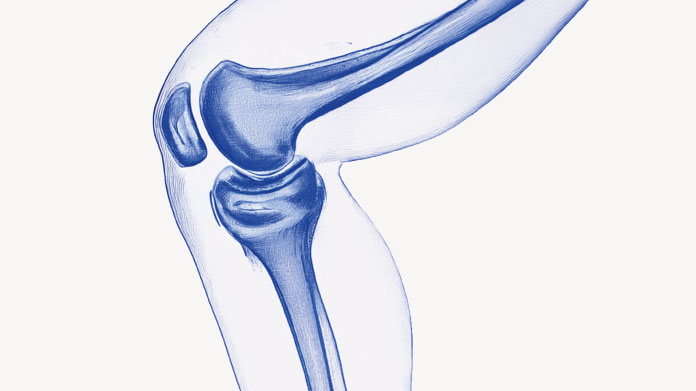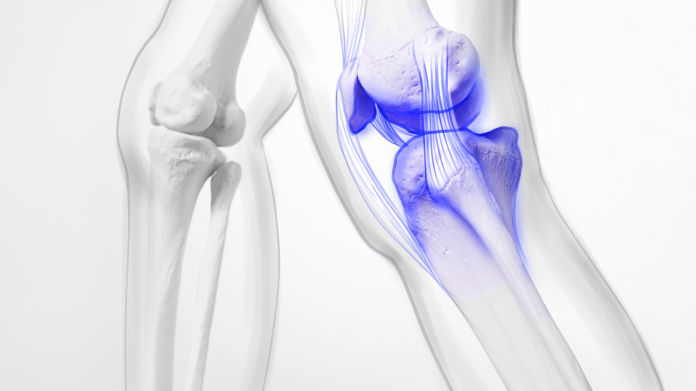Everything you need to know about joints!
In France, one in three people suffer (or will suffer) with painful joints. Here we give you the lowdown on what you need to do to prevent and treat joint pain, and the natural solutions available to help you.

‘Cracking’ joints are harmless
Contrary to widespread belief, ‘cracking’ of the joints, whether intentional or not, is not serious and in no way damages the joints. Joint ‘cracking’ may be due to an expansion of synovial fluid (the liquid surrounding our joints) but has no effect on joint health. However, it can mask a more troublesome problem (such as arthritis) if accompanied by pain or swelling, in which case it should be investigated.
Joint pain increases with age
Joint disease can occur at any age but it’s obvious that joint problemsgrow older. More than one in three people aged over65 thus suffer from joint pain, primarily in the supporting joints (hips and knees) as well as in the hands.
Exercise is invaluable for preventing joint pain
Participating in sports activity is good for the joints because it maintains their mobility as well as strengthening joint structure Regular, moderate , long-term exercise is therefore excellent not only for maintaining the joints but also for improving their condition in the case of recurrent pain. This is provided that that the exercise takes the form of a relatively gentle endurance sport (swimming, cycling, brisk walking …), especially in the case of existing pain. Conversely, the wrong choice of exercise can be just as harmful
Excess weight increases joint pain
It’s a simple question of mechanics. The heavier the load, the greater the strain on the joints and the quicker they will wear out. This is particularly – though not solely - the case with the lower limbs. Thus obese people are at greater risk of arthritis of the knee and of requiring ahip replacement, but they also suffer more regularly from arthritis of the hands and wrists. Studies have shown that simply being overweight (rather than obese) may have similar consequences. This is predominantly because gaining weight tends to make us move less, aggravating our joint problems.
Plants can be a useful remedy for joint pain
Many plants are recognised for their ability totreat and/or improve painful and problematic joints. They offer benefits both as a preventivemeadowsweet which contains salicylic acid that has the same effects as aspirin, turmeric which strengthens cartilage, and horsetail which improves collagen synthesis …
Natural anti-inflammatories are an option
Are you familiar with boswellia? Known by its scientific nameBoswellia serrata, this Indian tree is widely-used in ayurvedic products to treat rheumatic pain. And with good reason too! The latest research shows that boswellia (or its resin – the part most commonly used) acts as a powerful anti-inflammatory without generating anyside-effects. Other plants known for their anti-inflammatory properties include nettle, ash, harpagophytum (devil’s claw), and white willow … and they can (under the supervision of a health professional) be a useful substitute for conventional treatment to relieve inflammation of the joints.
The joints can be affected by many diseases
Rheumatism, osteoarthritis, rheumatoid arthritis, arthralgia - there are countless different disorders that can affect the joints. Moreover, the term « rheumatism » encompasses many different diseases. Damaged joints – whether as a result of trauma, a related disease (gout), transmission by bacteria (acute rheumatism of the joints) or by a tick (Lyme disease), or related to age or excess weight – can present various symptoms and degrees of severity.
You can ‘nourish’ your joints with carefully-targeted molecules
Several studies have shown that combining glucosamine with chondroitin, two molecules naturally present in the body and directly involved in cartilage formation and resilience, can help those suffering from osteoarthritis (results are more mixed when the two molecules are taken separately). Production of these two substances by the body is affected by age and joint disease. In such instances, supplementation (which must include a combination of the two molecules) may be a wise choice. According to a preliminary study, beneficial effects may be felt by 80% of patients, while other research has shown reductions in joint ‘cracking’, swelling and pain in the majority of patients.
Fatty acids and antioxidants play a role in joint health
You can protect against joint disease in the future or relieve pain and stiffness by eating a healthy, balanced and varied diet (which will also help prevent weight gain and thus the exacerbation of inflammatory processes), as well as by focusing on the right nutrients. Which nutrients are these? Antioxidants (found abundantly in fruits and vegetables), which combat oxidative stress and boost cell renewal of the cartilage matrix, fatty acids (present in oils, oily fish, etc) which reduce inflammation and wear and tear of cartilage, and vitamins and minerals which are essential for bone and joint formation. If you think your diet may be lacking in these essential nutrients, it’s a good idea to opt for targeted dietary supplementation.
Keywords
4 Days
Great customer service - responsive …
I ordered from them and my item was unavailable for sometime. I was super happy when they reactivated my order and shipped my item which arrived very quickly. Great customer service.
Ruth Rueter
5 Days
Super fast shipping
Super fast shipping
Donald Borling
8 Days
Reputable companysearch and the number of…
The research and the number of selection of products.
NAKHJAVAN Shervin
21 Days
The Anti Aromatase is a great product
The Anti Aromatase is a great product. You just need to have constant inventory. Recently this product has been out of stock.
GEORGE Verne
22 Days
Great help on chat
Great help on chat. Knowledgeable and friendly.
Jason Argos
26 Days
Customer service was fast and friendly.
Customer service helped to stop the transaction process of the subscription. I appreciated that.
Greenie
26 Days
I order here due to the high quality of…
I order here due to the high quality of the products and the quick delivery of items - thank you
Barbara J
27 Days
SuperSmart's Eye Pressure supplements: highly recommended!
I purchase SuperSmart's Eye Pressure supplements regularly for over 5 years, and gotta say they are truly a wonderful product for my Glaucoma. Highly recommended if you have eye pain from your Glaucoma.
D. Martinez
32 Days
Quick service
Quick service
MONELL
33 Days
Speedy service.
Speedy service.
ROSENTHAL Marvin
36 Days
Clear website- Efficient
Clear website. Excellent search engine and fast delivery!
Mohamad Hussein
39 Days
They have great products.
They have great products.
Vickie
39 Days
Great Shipping Time!
You Have A Great Shipping Time! Praise The Lord!
DMHoge
41 Days
Doctor Recommended!
Good pricing, very good availability, doctor recommended (couldn't find what I needed anywhere else), and it took only a week to arrive (which I can't complain about).
Al
42 Days
Great product and fast shipping
Great product and fast shipping
Marie





